Menu
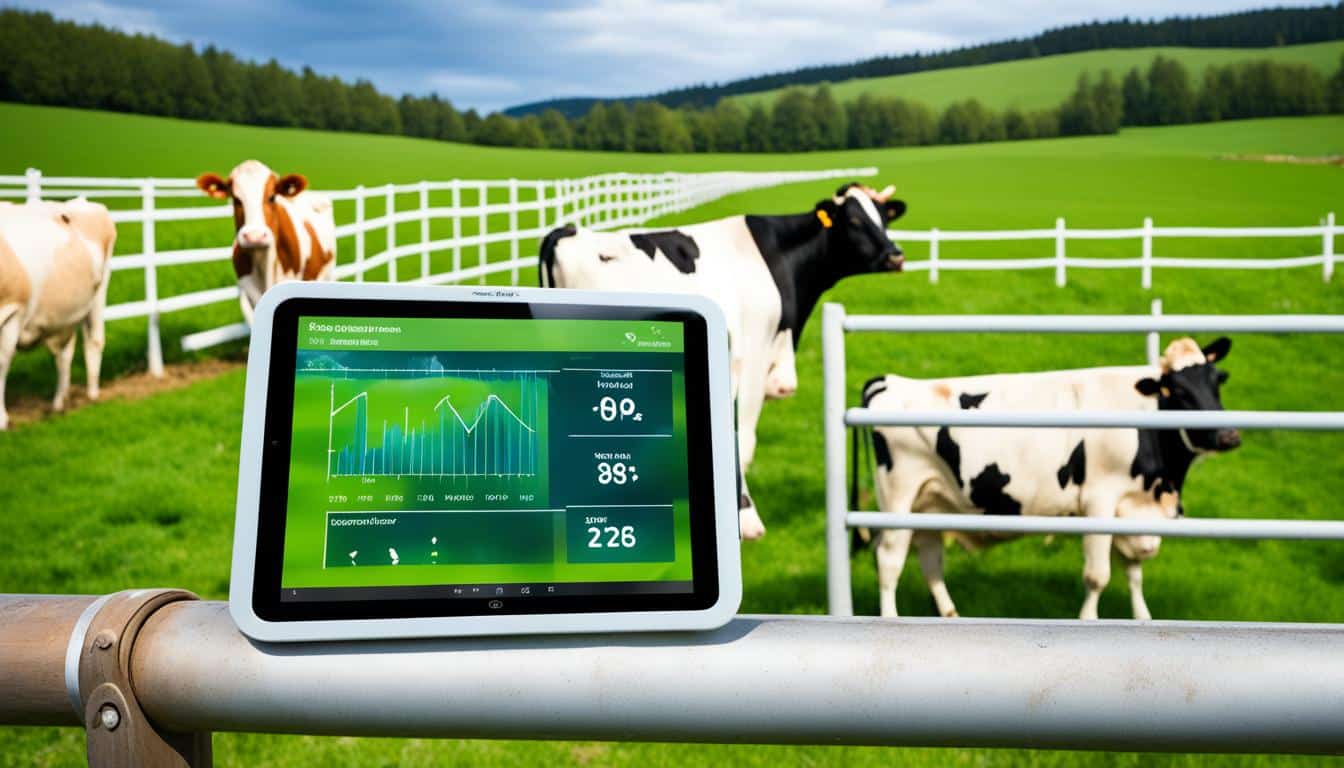
Agriculture causes 23% of human-made greenhouse gases and uses 92% of the world’s freshwater. Yet, up to 40% of the food we produce goes to waste. This situation calls for new solutions, especially in digital agriculture or AgTech. This field uses real-time data analytics, artificial intelligence, and precision farming tools, among others.
AgTech started blooming in the late 20th century with the spread of the Internet of Things, connectivity, and big data. At first, farmers were slow to adopt these new technologies due to the risks involved. However, the benefits of smart farming solutions are clear. They are now widely embraced by farmers everywhere.
Digital agriculture uses various tech tools to help farmers better manage their work. These include things like real-time data analytics, artificial intelligence, and precision tools. By using these tools, farmers can make their farms more productive, reduce waste, and farm in more sustainable ways.
Digital agriculture has come a long way, thanks to many tech advances. At first, farmers hesitated. They worried about high costs and tech’s complexity. They also weren’t sure the tech would pay off. But, the more they saw how it helped with farming and managing data, the more they used it.
In the US, over 80% of farms haven’t fully adopted any one digital tool. This is mainly because of the cost, how complex they are, and the slow return on investment. But, companies like John Deere are changing that. They’ve spread digital tech over 330 million acres worldwide. This shows the real value and impact of these tools in agriculture.
Farmers deal with many problems like pests, lack of workers, and needing to use resources carefully. The need to find new ways to solve these problems has pushed more farmers towards using digital tech. Also, having a common way to use and share data is key. It helps different systems work together smoothly.
It’s time for the digital farming industry to focus on solving real problems in farming. New solutions should be easy to scale and use. They should also put the farmer first and keep their data safe. Thinking one technology can fix everything is wrong. It’s clear we need a mix of technologies to really help farmers.
There’s a growing demand for advanced farming solutions, like the Monarch Tractor’s MK-V. This tractor is electric, drives itself, and is always connected. In places like California, special programs help farmers buy such tech for a lot less. This kind of support makes farmers more open to using new, smart tools.
Using precise farming methods, which are supported by on-the-spot data and GPS, makes a big difference. It boosts crop yields and makes farming more efficient. Even though these machines cost a lot at first, they save money in the long run. They cut down on the need for extra workers, use less weed killer, and make the soil better.
Many governments are offering money to help farmers use smarter, more sustainable methods. Plus, the digital farming sector keeps growing fast. All this points to a new, fourth agricultural revolution. And this time, what’s leading the way is how well different farming tech and data can work together.
Still, there are big worries around the world about farming tech. Things like needing a stable internet, farmers needing to understand tech better, high costs, and keeping data safe are major issues. And, places with less money and smaller farms might fall behind. This could make the gap between different farms even bigger.
| Concerns | Details |
|---|---|
| Internet Connectivity | Stable connection required for functionality |
| Tech Literacy | Operating complexity can deter adoption |
| High Costs | Initial and ongoing investments are significant |
| Data Security | Risks of hacking and data breaches |
There’s a huge potential for digital farming. But making it real depends on solving these big concerns. By making different tech work well together and helping farmers through government and industry plans, we can make farming even better. The key is a smooth change to smarter, more productive, and sustainable farming.
Today, the agriculture industry is rapidly advancing. Digital farming solutions are key for boosting farm productivity and managing resources well. They use the latest technologies to help farmers run their operations better and sustain environmental practices.
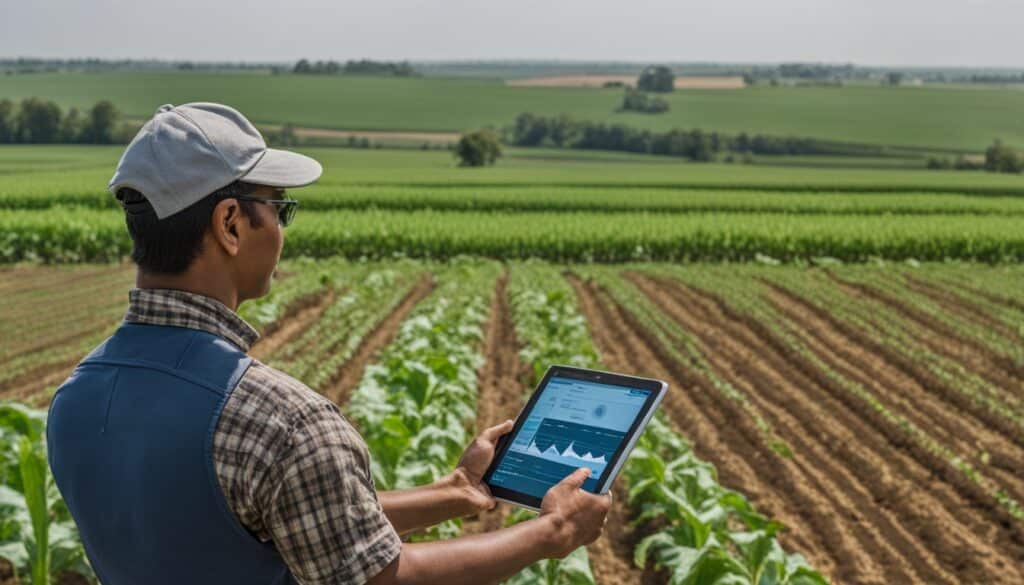
Digital farming tools boost how much farmers produce and earn. They use real-time data to give insights on farm activities like tractor speeds and fuel use. This helps farmers decide on planting and equipment use, making their work more efficient.
Take the Monarch Tractor’s MK-V, for example. It’s an electric, self-driving tractor that’s internet-connected. It’s a big step forward, promising good profits despite its high cost.
There are also financial perks to using these technologies, like tax breaks and payment help. In California, farmers can cut MK-V costs by up to 60% with certain programs. These benefits make the big starting costs of digital farming easier to manage.
Digital agriculture is also good for the environment and farm success. With advanced tech, farmers can spot and tackle risks before they become major issues. This is key for dealing with problems caused by the changing climate, like soil loss and extreme heat.
Using fewer petrol-based chemicals makes food supplies more reliable and eco-friendly. The push for sustainable food production is meeting consumer needs.
High-tech tools like GPS and smart analytics help farms run more efficiently. John Deere, for instance, is working on 330 million acres worldwide with such tools. This shows how popular these digital solutions are becoming.
Yet, there are hurdles to using more digital tools. Cost, complexity, and a belief that one tech can do everything are big challenges. We need to work on combining different tools, making data sharing easier, and protecting user data to move forward.
The world’s farming sector is facing a challenge. It must feed a rapidly growing population set to hit 10 billion by 2050. To tackle this, artificial intelligence (AI) in farming, machine learning, and predictive analytics are key. They are changing how the industry works.
Machine learning is making big differences in how farmers understand their land. It uses AI to sift through loads of data. This includes info from IoT gadgets and satellite images. It helps plan when to grow crops, tackle pests, and know the weather better. Tools like computer eyes watch the soil. They find how healthy the crops are and what they might need. It saves resources yet boosts harvests.

Predictive analytics give farmers a heads-up on possible troubles. Like bad weather, bugs, or diseases that could harm crops. Using special AI models, farmers get advice on what to do from planting seeds to harvest. It makes farming smarter and cuts down on losses. AI drones with smart cameras also help. They spray pesticides exactly where needed. This helps the environment and keeps farmworkers and food safe.
| AI Benefits | Application | Impact |
|---|---|---|
| Improved Crop Monitoring | AI-powered drones, Computer vision | Optimal pesticide use, enhanced crop health |
| Resource Management | IoT sensors, AI algorithms | Efficient water use, sustainable farming |
| Risk Mitigation | Predictive analytics | Anticipate weather/pests, reduce losses |
| Precision Agriculture | Machine learning | Increased yield, reduced costs |
The AI in farming market is poised to get much bigger, from 1.7 billion USD in 2023 to 4.7 billion by 2028. This shows how much more we’ll use AI to help small farmers. It will give them better tools to grow more and earn more. But, there are still hurdles like not enough tech and training. So, teamwork between governments, tech firms, and schools is vital. It makes sure AI’s benefits reach all farmers.
Precision agriculture software changes how farming works with its precise control over inputs. It uses technologies like GPS, drones, and satellite images to give farmers important details. This includes crop health and weather updates. With this info, farmers can make better choices, boosting their work’s effectiveness and the food they grow.
This software’s standout feature is better crop yields. Fields are sectioned off for more focused farming. This means farmers use exactly the right amount of fertiliser and save on fuel. It cuts down costs and uses resources better, making farms more efficient and productive.
Despite its great advantages, using precision agriculture software can be tough. Dealing with lots of data, linking different data types, and the initial costs are hurdles. But, the software’s upsides easily beat these problems.
Despite the challenges, more and more farmers are choosing this software. In the USA, it helps farms be more sustainable, profitable, and kind to the environment. By using precision agriculture software, farmers can get more work done and grow food better. This meets the needs of a sustainable and money-making agriculture sector.
| Technology | Benefits |
|---|---|
| GPS & Drones | Give up-to-date info on crops and weather |
| Variable Rate Application | Applies fertilisers, chemicals, and seeds as needed |
| Satellite Remote Sensing | Provides detailed info for instant yield checks |
| GIS Technology | Makes accurate farm maps for better management |
Precision agriculture uses drones, GIS tools, IoT gadgets, sensors, remote farm gear, and data predictions.
To sum up, precision agriculture software isn’t just good for boosting crop yields and smarter farming. It’s also key to keeping farming sustainable and profitable today.
By 2050, the world’s food demand is estimated to rise by 70%. This increase is due to our growing population. But, nearly 10% of the population is still hungry. This shows why we need advanced farming technologies. These technologies help make sure we have enough food.
Farming apps and real-time data are changing how we farm. They make farming more productive and efficient. They help farmers grow more food with fewer resources.
Real-time data is key in farming technology. By 2028, the market for precision farming is expected to be worth $16.35 billion. This technology lets farmers check their fields any time. This helps them decide when to plant and fertilise. It also helps them use water and nutrients better.

GPS and remote sensing are vital in farming apps. With these tools, farmers can see real-time data on their land. They know the health of their soil, the moisture, and the crops. Knowing this information helps farmers grow more food without wasting resources.
Remote sensing is especially helpful. It gives farmers advice on when to plant and how much water to use. Thus, it improves how farms are managed.
| Agritech Solution | Benefits | Example |
|---|---|---|
| Real-time Data Analytics | Optimises resource use; timely decision-making | ICL Group’s Agmatix |
| GPS Technology | Accurate field mapping; enhanced precision | Idroplan’s smart irrigation systems |
| Remote Sensing | Improved crop monitoring; data-driven insights | Drone Photography Services |
In our changing world, autonomous farm machinery is transforming agriculture. It helps farmers boost productivity and cut costs. The Monarch Tractor MK-V shines through, combining electric power with autonomous features.
Farmers save money by using labour-saving farm technology. Autonomous machines work day and night, without breaks. This means more work gets done without the cost of human labour.
Precision agriculture is key to better farming through technology. It uses tools like drones to scout fields and spot problems early. By using less chemicals, it also helps the environment.
Using advanced tech doesn’t just help the bottom line. It also makes farms more eco-friendly. With more efficient use of land and energy, these methods lessen farming’s impact on the planet.
The future of farming is autonomous. Machines like the Monarch Tractor MK-V are in high demand. They help meet the growing need for food while farming more sustainably.
As a farmer, I know how important these new machines are. They are changing farming for the better. They make our work safer, smarter, and good for the planet.
Digital tools are changing how well crops grow. Systems like targeted irrigation and variable-rate applications have become vital for better productivity.
In farming, targeted irrigation is making a big difference. It applies water precisely, ensuring crops get just what they need. This has made managing water smarter, especially in areas where weather changes a lot.
In Argentina, using precise irrigation led to a 54% crop increase. This high-tech farming reduces water waste and boosts crop growth markedly. It shows clearly how digital tools are reshaping farming.
Another game-changer is variable-rate applications. They allow farmers to use fertilisers and pesticides only where they’re required. In the U.S., these systems raised crop yields by 13%.
By using soil mapping, farmers improve their harvests but also protect the environment. This lessens harmful chemicals’ use, showing the power of digital tools for better farming and a greener planet.
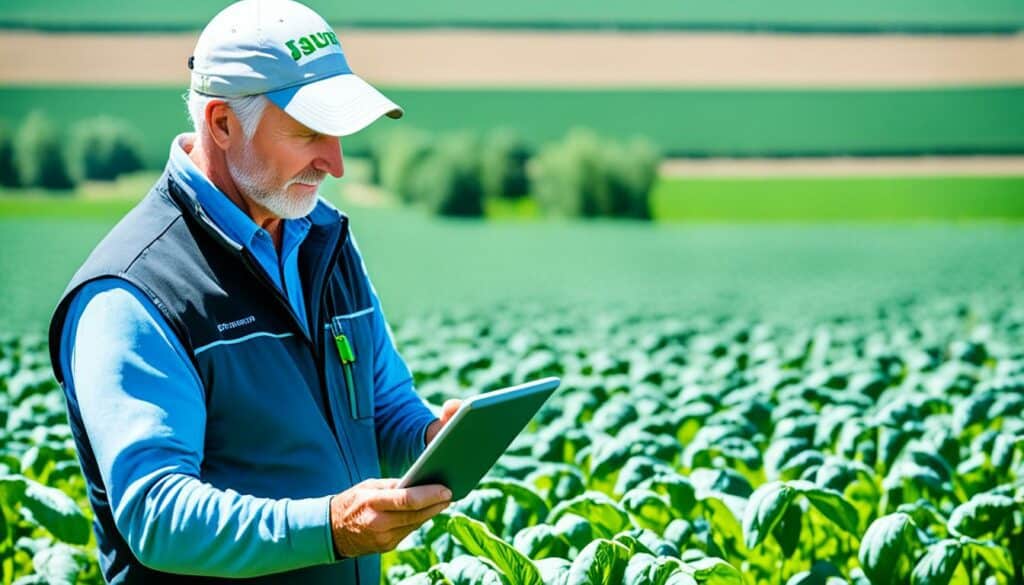
| Region | Yield Increase | Technology |
|---|---|---|
| U.S. | 13% | Soil Mapping |
| Argentina | 54% | Precision Agriculture |
| Scotland | N/A | Smart Collars |
The figures clearly show how much better farming has become with digital tools. Looking to the future, it’s obvious that digital farming impact will keep growing. Targeted irrigation, and variable-rate applications are key for boosting crops worldwide.
In today’s changing farm world, digital farm management tools are a must-have. They use tech to make farms work better and produce more. Thanks to things like real-time data and artificial intelligence, farmers can make smarter choices when they plant and harvest.
Now, farmers can see live updates on how their tractors are running or how their crops are growing. They can use this info to use less, but do more. For example, Monarch Tractor’s WingspanAI helps farmers figure out the best ways to grow more food.
In 2023, Monarch Tractor made the MK-V – an electric, self-driving tractor that connects to the internet. It’s the start of a new era, making farms run better and do more.
These new tools don’t just save time. They can also save money and help make more food. Things like precise watering, advanced animal management, and self-driving machines can make farms more profitable and efficient.
Adding predictions and smart risk management makes farming even smarter. Farming tools and apps also help keep track of how farms are run, which is important for following rules and sharing info with others.
Digital farming is what many shoppers want – farming that’s good for the planet, uses less, and works better. As these tools get better, they will help farming grow in a way that’s good for everyone.
In today’s rapidly growing global market, smart farming is changing how we manage livestock. By 2027, smart and precision agriculture could be worth 33 billion USD. This growth points to the vital need for smart solutions in handling the challenges of a growing global population.
Advanced monitoring tools are leading this change. They allow farmers to keep a close eye on animal health and behaviour. This means better care for the livestock, improving their life and welfare.
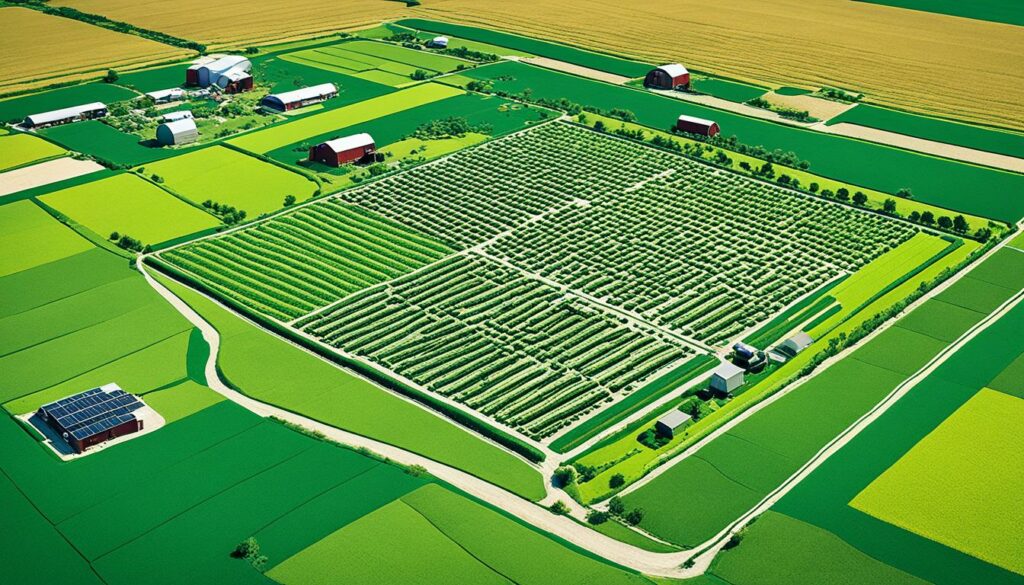
Smart sensors are cutting down on manual work and mistakes made by people. They’re making farms more efficient and cutting costs. For example, the Quanturi sensors have stopped 1000 farm fires in five years, saving 100 million USD worth of damage.
These devices keep check on the farm’s environment, managing the health of animals better. They’re also helping to use resources more wisely. This leads to better products and more yield.
Innovations like the HAYTECH Feed Value Indicator and Quanturi grain monitoring are making a big difference. They help spot risks and use resources better. For instance, smart farming’s use of IoT means farmers don’t have to manually track livestock. This real-time tracking helps keep animals healthier.
While these advanced technologies can be costly at first, their long-term benefits for farmers are great. Governments are pushing for smart agriculture too. But, there are still challenges like privacy, lack of tech know-how, and complex rules.
The future of livestock monitoring is bright. Growing interest in smart and precision farming is expanding the market. With AI and big data in the mix, there are new chances to improve animal health management. As smart agriculture reaches more places, these technologies will become even more important for farmers worldwide.
E-agriculture is making big changes in farms around the world. It brings together over 12,000 people from 170 countries. They share their ICT knowledge to help make farming better and more sustainable.
Through e-agriculture, a big network is growing. It’s spreading new farming tech, like in the U.S. where peanut farms are producing 9% more.Argentina, on the other hand, has seen a huge 54% increase in farming output by using precision farming. In Scotland, they’re using smart collars for better livestock management. It’s improving farm productivity and looking after the animals better.
Developing countries are also benefiting from e-agriculture. A wheat farmer in Sudan increased his yield four times in just a year. This shift turned his losses into a good profit.
Even with problems like poverty and lack of resources, e-agriculture offers sustainable solutions. Technologies like precision planting and automated horticulture are making farming more efficient. Drones are also cutting down on waste. This highlights how e-agriculture is helping rural areas grow economically.
Sustainable farming technology plays a key role in reducing damage to our planet. It helps farmers use resources better and lowers the harm to the environment. Many farmers are now using advanced tools, as seen in the “Survey for smart farming technologies: challenges and issues,” to practice sustainable farming.
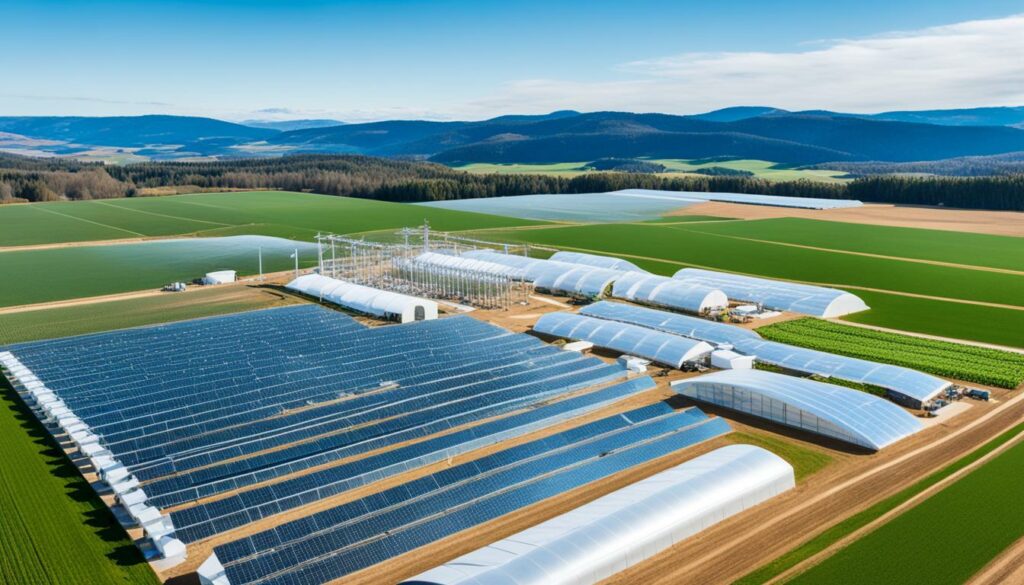
Sustainability tech aims to cut down the use of harmful chemicals. This helps keep the soil and nature healthier in the long run. For example, precision farming allows farmers to use water, fertilizers, and pesticides very precisely. This cuts down on waste and makes farming more eco-friendly.
| Technology | Environmental Benefits |
|---|---|
| Precision Farming | Minimises waste, optimises input use |
| Vertical Farming | Uses less land and water, controlled environment |
| Robots in Agriculture | Reduces manual labour, increases efficiency |
| IoT Devices | Monitors soil moisture & crop health in real-time |
The article, “Robots in agriculture: prospects, impacts, ethics, and policy,” shows the benefits of using robots in farming. These machines boost productivity, cut down on hard manual work, and allow for more precise farming. With the need to make 60% more food by 2050, these technologies are vital for lessening the impact on our planet.
Tools like livestock wearables and monitoring systems are improving how we care for farm animals. They keep an eye on their health and comfort in real-time. Adding sensors and IoT devices to farms helps track important factors like soil health and climate. This makes farming more eco-friendly.
Thanks to the ongoing development and spread of these farming technologies, we’re getting closer to a greener future in agriculture. This will benefit the planet and make farming better for the generations to come.
Digital platforms for sharing equipment are changing how farming works. They make it easier to use expensive machines and create chances to make money. For small and medium farms, this is especially helpful. It lets them save money by sharing equipment and use resources better.
The idea of “Uber for tractors” is catching on. It means farmers can rent their unused machines to others who need them. This way, they don’t have to buy more machines. By sharing, they can grow their farms without spending too much on machinery.
Using shared equipment creates new chances in farming. It makes farming cheaper and brings new technology to more farmers. Also, farmers can make extra money by renting out their machines when they’re not using them. This helps the whole farming sector grow.
| Country | Farm Yield Improvements | Technology Used |
|---|---|---|
| U.S. | 9% increase in peanut yields | Precision agriculture technologies |
| Argentina | 54% hike in farm output | Precision agriculture and soil maps |
| Scotland | Enhanced productivity and animal welfare | Smart collars by Silent Herdsman |
These sharing platforms will keep getting better. They’ll offer more tools, like managing soil health and carbon credits. Farmers love these platforms for helping with soil health, using satellite images, and real-time checks. Once farming starts using these tools more, it will become more efficient and green.
The future of artificial intelligence (AI) in farming looks bright. It is ready to bring big improvements in how we produce food. By 2050, we expect to reach a global population of 10 billion. This puts huge pressure on the farming sector to grow more food efficiently. AI’s involvement is vital in this change. The AI in agriculture market is predicted to rise significantly. It could leap from USD 1.7 billion in 2023 to USD 4.7 billion by 2028, according to MarketsandMarkets. This growth shows how important AI has become in farming.
AI can really boost our ability to predict. Its predictive power lets farmers process vast amounts of data quickly. This helps in figuring out what crops to grow based on market needs, foretelling prices, and pinpointing the best times to plant and harvest. With these insights, farmers can then make choices that save money. They can increase their harvests while reducing their use of resources. Plus, AI tools like driverless tractors, smart irrigation systems, drones, and robots in greenhouses are more precise and efficient than manual labor.
AI isn’t just for growing crops better. It can also improve how we manage water for these crops, spot leaks, watch over crop and soil health, find diseases and pests, and use pesticides wisely. For example, it can tell us exactly when wheat and tomatoes are ready for harvest. With AI’s unmatched precision and speed, farming becomes not only more productive but also tackles big problems like crop destruction and soil damage. These issues cause huge financial losses and affect many people globally.
Looking ahead, AI’s role in farming is to make agriculture sustainable and strong. Think about vertical farms with robot workers. They can grow fresh food all year using much less water than ordinary farms. This shows us the power of AI to change farming for the better. But, challenges like job changes and ethical worries are real. However, the potential for AI to boost technology and reform farming is exciting. We just need to use AI in farming wisely. This way, AI can help create a thriving and earth-friendly future for everyone.
Digital tools such as real-time data analytics are key for better farm productivity. They help with efficient resource use and operation monitoring. This leads to more agricultural outputs and high yields.
Major advancements include AI, real-time analytics, precision tools, automated machinery, and robotics. These have become very important in improving how we manage farms and optimising our work.
Digital farming improves how farmers make decisions and use resources. It boosts profits and crop yields. Plus, it helps the environment by reducing the use of harmful chemicals. It also tackles climate issues.
Artificial intelligence offers advice on crop rotation and dealing with pests. It does this through analysing data and predicting weather. This helps farmers make smart decisions and handle risks better.
Precision software makes farming more efficient. It lets farmers manage their resources better. It also helps with keeping farm records and meeting regulations. This boosts farm productivity.
New technologies like data analytics and GPS are changing how we manage crops. They give insights on field conditions. This leads to more precise planting and care practices.
Autonomous machines are changing the game with their remote control. They cut the need for workers and save money. They also make farming safer and reduce harm to the environment.
Digital tools make farming more precise with VRA and targeted irrigation. These allow exact use of water and resources. Less waste and better crops are the result.
Key digital tools for farms are management software and precision tools. They are essential for efficient operations and improving output.
High-tech systems keep an eye on animals’ health and behaviour in real-time. This helps farmers care for livestock better. It also boosts farm efficiency and animal health.
E-agriculture efforts share ICT knowledge to improve farming worldwide. They help agriculture be more productive and eco-friendly, especially in developing areas.
Sustainable tech makes farming greener by using resources better and cutting back on chemicals. This helps make farming friendlier to the planet.
Digital platforms make sharing farming equipment easier and cheaper. They help farmers make more use of machines, saving money and creating new opportunities.
AI will keep improving farming by predicting more, making better decisions, and upping automation. These changes will make farming more efficient and change how we farm.